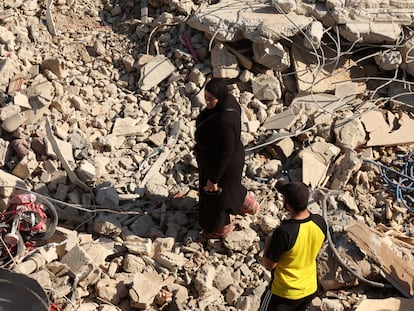Netanyahu announces ceasefire with Lebanon, vows to respond ‘with force’ if Hezbollah violates it
The Israeli prime minister has celebrated the agreement, which allows Israel to continue bombing Gaza (’Hamas is left alone’) and shift its focus to Iran. Meanwhile, the army took advantage of the final hours to strike Beirut with unprecedented intensity
With a tone more resolute than optimistic, Israeli Prime Minister Benjamin Netanyahu announced on Tuesday a cease-fire agreement with Lebanon, cautioning that its duration will depend on “what happens” in the neighboring country. He emphasized that Israel will respond “with force to any violation” by Hezbollah. Speaking in a televised address with evident pride, Netanyahu hailed the agreement for separating the Gaza and Lebanon fronts. “Hamas counted on Hezbollah, but with Hezbollah now out of the equation, Hamas is left alone,” he said. “This increases our pressure on Hamas and supports the sacred mission of freeing our hostages”
Netanyahu added that the cease-fire will enable Israel to focus on its primary adversary, Iran, and clear the way for previously delayed arms shipments from the United States, Israel’s staunch ally.
While Netanyahu did not specify when the cease-fire will take effect, it is expected to end 11 months of low-intensity conflict with Hezbollah and two and a half months of intense warfare that have resulted in nearly 3,800 deaths in Lebanon. The violence has displaced hundreds of thousands, leaving many without homes or livelihoods, and has severely weakened the Lebanese party-militia. For Israel, the agreement means some 90,000 citizens can return to their homes.
In the final hours before the cease-fire, the Israeli military launched an intense bombardment of Beirut, including strikes on central areas previously untouched by conflict. The city was gripped by fear, with civilians taking refuge in hospitals, traffic jams as residents attempted to flee, and ambulances struggled to navigate the chaos.
U.S. President Joe Biden and French President Emmanuel Macron are set to make an announcement later Tuesday, with a parallel statement from Lebanese Prime Minister Najib Mikati. The deal consists of a 60-day cease-fire, intended to transition into a permanent resolution. During this period, the Israeli army will maintain its presence in southern Lebanon, where it has advanced since October. On Tuesday, it reached the Litani River — 18 miles from the border — for the first time since its withdrawal in 2000 after its 18-year-long occupation of southern Lebanon. Hezbollah, in turn, will withdraw its fighters and weapons north of the river.
Following the 60-day period, the Israeli military is expected to withdraw, allowing for the deployment of 5,000 Lebanese Armed Forces troops to oversee adherence to the terms of U.N. Resolution 1701, which ended the 2006 conflict between Israel and Lebanon. Troops from the U.N. Interim Force in Lebanon (UNIFIL), which monitors compliance with the resolution, will also be deployed.
Israel’s security Cabinet quickly approved the agreement during a meeting that began at 5:00 PM local time. Netanyahu, who supports the deal alongside top security officials and his inner cabinet, announced plans to present it to the full Council of Ministers later in the evening. Although the agreement enjoys broad backing, three ministers and several northern mayors — whose regions have suffered from Hezbollah’s missile and drone strikes since October 2023 — are opposed to the deal in principle.
The agreement reflects Hezbollah’s diminished strength following significant losses, including the death of longtime leader Hassan Nasrallah and most of its senior command. Israel estimates that 3,000 Hezbollah fighters have been killed, with hundreds more sidelined by hand and eye injuries caused by the September Mossad detonation of walkie-talkies and pagers. Hezbollah has sought to minimize the impact, and on Tuesday released a video titled “Despite the Wounds, We Are Still on the Ground,” showing injured fighters handling rockets and ammunition in an attempt to project resilience.
The clearest sign of Hezbollah’s weakened position is its decision to agree to a ceasefire deal that does not force Israel to stop bombing Gaza, a demand it had adamantly maintained for months. This concession underscores the group’s reduced leverage, compounded by Lebanon’s ongoing economic crisis, which has pushed the poverty rate from 12% in 2012 to a staggering 44% by 2022, the latest available figure.
For Israel, the decision to agree to a cease-fire was driven not only by the advantage it now holds, but also by the necessity of relieving its overstretched military. Professional soldiers and reservists — many of whom have been called to duty up to three times — are showing signs of fatigue. Earlier this month, local media reported that the reservist response rate had fallen to 75-85%, down from the near-total turnout seen after the Hamas attacks on October 7, 2023. Commentator Ben Caspit warned in Maariv that the situation on the Lebanese front could only “get worse from now on.”
Before announcing the ceasefire, Israel ramped up its operations with a surge of bombings. In Beirut, the Israeli air force struck 20 targets in Dahieh, Hezbollah’s stronghold in the southern suburbs within, in the space of a few minutes. It also brought down a building in the city center without prior evacuation notice, and bombed the Rashidiyya Palestinian refugee camp near Tyre for the first time, resulting in nine reported deaths. Israeli forces also issued an unprecedented warning, advising all “the inhabitants of Lebanon” that it was preparing to attack “numerous branches of Al-Qard Al-Hassan,” Hezbollah’s microcredit network.
The latest directives from the Israeli army, shared by its Arabic-language spokesman Avichai Adree, include targeting four buildings in central Beirut — areas previously untouched by the conflict. These locations include Ras Beirut, near a station and a church, and Mazraa and Zokak el-Blat, just meters from two schools. Some of these buildings house Shiite families displaced by the ongoing war. Meanwhile, Hezbollah limited its actions to launching a dozen projectiles toward Haifa, Israel’s third-largest city, and the Galilee region.
Sign up for our weekly newsletter to get more English-language news coverage from EL PAÍS USA Edition
Tu suscripción se está usando en otro dispositivo
¿Quieres añadir otro usuario a tu suscripción?
Si continúas leyendo en este dispositivo, no se podrá leer en el otro.
FlechaTu suscripción se está usando en otro dispositivo y solo puedes acceder a EL PAÍS desde un dispositivo a la vez.
Si quieres compartir tu cuenta, cambia tu suscripción a la modalidad Premium, así podrás añadir otro usuario. Cada uno accederá con su propia cuenta de email, lo que os permitirá personalizar vuestra experiencia en EL PAÍS.
¿Tienes una suscripción de empresa? Accede aquí para contratar más cuentas.
En el caso de no saber quién está usando tu cuenta, te recomendamos cambiar tu contraseña aquí.
Si decides continuar compartiendo tu cuenta, este mensaje se mostrará en tu dispositivo y en el de la otra persona que está usando tu cuenta de forma indefinida, afectando a tu experiencia de lectura. Puedes consultar aquí los términos y condiciones de la suscripción digital.
More information
Archived In
Últimas noticias
Most viewed
- Sinaloa Cartel war is taking its toll on Los Chapitos
- Oona Chaplin: ‘I told James Cameron that I was living in a treehouse and starting a permaculture project with a friend’
- Reinhard Genzel, Nobel laureate in physics: ‘One-minute videos will never give you the truth’
- Why the price of coffee has skyrocketed: from Brazilian plantations to specialty coffee houses
- Silver prices are going crazy: This is what’s fueling the rally











































